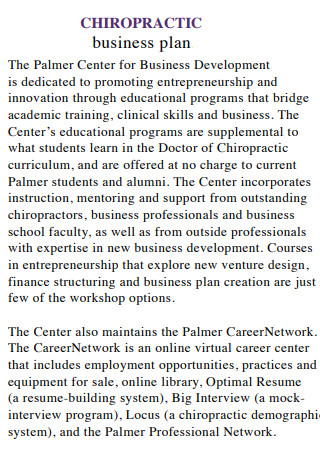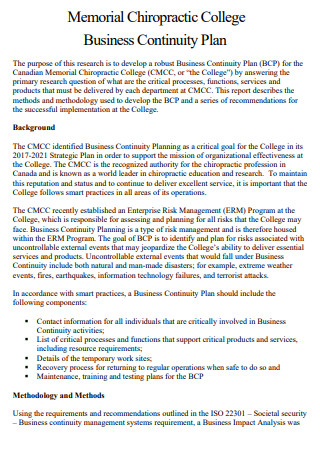8+ SAMPLE Chiropractic Business Plan
-

Chiropractic Business Plan
download now -

Chiropractic Small Business Plan
download now -

Sample Chiropractic Business Plan
download now -

Chiropractic College Business Plan
download now -

Taylor Sport Chiropractic Business Plan
download now -

Chiropractic Center Business Plan
download now -

Chiropractic Association Business Plan
download now -

Family Chiropractic Clinic Business Plan
download now -

Chiropractic Business Continuity Plan
download now
FREE Chiropractic Business Plan s to Download
8+ SAMPLE Chiropractic Business Plan
What Is a Chiropractic Business Plan?
What Is a Chiropractor?
What Conditions Do Chiropractors Treat?
How Is a Chiropractic Adjustment Performed?
What Are the Chiropractic Strategies to Get Started?
FAQs
Is chiropractic treatment appropriate for children?
What type of education and training do chiropractors have?
5 common reasons why chiropractic businesses fail, and what to do to turn failure into success:
Is chiropractic treatment safe?
What is the difference between a chiropractor and an osteopath?
Can chiropractors write prescriptions?
What Is a Chiropractic Business Plan?
Chiropractic care is a competitive business. Chiropractic clinics are an alternative modality that supplement conventional medicine. The aim is to improve spinal mobility. This usually means adjusting various parts of the spine, including the low, middle, and upper back area, as well as the neck. Patients often choose this type of therapy when they are dissatisfied with conventional treatments or want pain relief that conventional medicine does not offer. Finding the right people can be hard, and keeping them can be even harder.
Demand for chiropractic medicine has been growing over the last few years. Growth is due to acceptance by many insurance policies, and an increase of published research that indicates the effectiveness for patients.
What Is a Chiropractor?
Chiropractic is a healthcare profession that cares for a patient’s neuromusculoskeletal system—the bones, nerves, muscles, tendons, and ligaments. A chiropractor helps manage back and neck pain through the use of spinal adjustments to maintain good alignment.
Chiropractic is focused on the body’s ability to self-heal and includes other treatments like nutrition and exercise.
A chiropractor is trained to make sure your body is functioning as optimally as possible by using spinal manipulations to relieve pain in your joints and muscles. These spinal adjustments will increase blood flow and nerve conductivity to the joints and muscles that are experiencing pain.
What Conditions Do Chiropractors Treat?
Doctors of Chiropractic care for patients of all ages, with a variety of health conditions. They are well known for their expertise in caring for patients with back pain, neck pain, and headaches using their highly skilled manipulations or chiropractic adjustments. They also care for patients with a wide range of injuries and disorders of the musculoskeletal system, which includes the muscles, ligaments and joints. These painful conditions may involve or impact the nervous system, which can cause referred pain and dysfunction distant to the region of injury. Moreover, chiropractors offer advice to patients on diet, nutrition, exercise, healthy habits, and occupational and lifestyle modification.
How Is a Chiropractic Adjustment Performed?
Chiropractic adjustment or manipulation is a manual procedure that utilizes the highly refined skills developed during the doctor of chiropractic’s intensive years of chiropractic education. Chiropractic manipulation is a highly controlled procedure that rarely causes discomfort. The chiropractic physician typically uses his or her hands or an instrument to manipulate the joints of the body, particularly the spine, in order to restore or enhance joint function. This often helps resolve joint inflammation and reduces the patient’s pain. The chiropractor adapts the procedure to meet the specific needs of each patient. Patients often note positive changes in their symptoms immediately following treatment.
What Are the Chiropractic Strategies to Get Started?
FAQs
Is chiropractic treatment appropriate for children?
Yes, children can benefit from chiropractic care. In the case of children, it is very gentle. Children are very physically active and experience many types of falls and blows from activities of daily living as well as from participating in sports. Injuries such as these may cause many symptoms including back and neck pain, stiffness, soreness or discomfort. Chiropractic care is always adapted to the individual patient.
What type of education and training do chiropractors have?
Doctors of chiropractic are educated as primary-contact healthcare providers, with an emphasis on diagnosis and treatment of conditions related to the musculoskeletal system (the muscles, ligaments and joints of the spine and extremities) and the nerves that supply them. Educational requirements for doctors of chiropractic are among the most stringent of any of the healthcare professions. The typical applicant for chiropractic college has already acquired nearly four years of pre-medical undergraduate college education, including courses in biology, inorganic and organic chemistry, physics, psychology and related lab work. Once accepted into an accredited chiropractic college, the requirements become even more demanding — four to five academic years of professional study are the standard. Doctors of chiropractic are educated in orthopedics, neurology, physiology, human anatomy, clinical diagnosis including laboratory procedures, diagnostic imaging, exercise, nutrition rehabilitation and more. Because chiropractic care includes highly skilled manipulation and adjusting techniques, a significant portion of time is spent in clinical technique training to master these important manipulative procedures.
5 common reasons why chiropractic businesses fail, and what to do to turn failure into success:
1. Lack of Patient Awareness. What happens if a chiropractic practice fails because no one knew it was there? The lack of patient awareness is a major cause of chiropractic business failure. Chiropractic is not a “if you build it, they will come” sort of venture. It is not enough to simply open an office and expect patients to flock to it. Chiropractors know this, but they often are not using the right type of marketing to let people know they exist and can serve their needs. It is crucial to advertise and market correctly, including using social media.
2. Lack of Delegation. Everyone gets the same 24 hours in a day, and there is only so much any one person can do in that time. Too many chiropractors try to carry the majority of the workload themselves, without delegating appropriate tasks to employees. The bottom line is that you cannot do it all yourself; trying to do so may mean crucial elements of your business are falling between the cracks. While you may have to take on more tasks than you like in the very beginning, it is important to hire good staff as soon as possible and delegate the work accordingly.
3. Not Maintaining a Business. Plan A good chiropractic business plan in and of itself won’t make a practice successful. However, that is generally because once the chiropractic business plan is completed and the lender has agreed to finance the practice, the plan goes back on the shelf and is never referred to again. That’s a mistake. Your chiropractic business model/plan should include and allow you to track your metrics for success, determine priorities, and help you build toward the future. An annual review lets you know if your business is on track at a macro level. If your business isn’t on track, making changes to your chiropractic business plan forces you to address and confront the issues your business faces and devise ways to overcome them before things get out of control. Knowing the numbers on at least a weekly basis is vital for a successful practice. If there are significant revenue drops over short periods of time, find out the cause and rectify problems before they get out of hand.
4. Lack of Organization. Patients will cancel appointments. That’s human nature. However, a practice that fails to contact these patients and reschedule them shows serious structural problems. The right software for your chiropractic assistants ensures that patients are not left behind, missed appointments are rescheduled and your office runs smoothly. A well-run office impresses the patients. An office that makes a lot of errors or appears disorganized turns them off.
5. Not Billing Correctly. You may be doing everything right, as far as you know, and have a healthy patient base, but what if your profits just aren’t adding up as they should? The culprit is likely your billing system. The right chiropractic practice management and billing system can make the difference between chiropractic success and failure. You should not have employees entering data manually, increasing the odds of mistakes. Payments and claims should be posted and submitted automatically. If a patient’s insurance has expired or they have reached their visit maximum, you need software that tells you beforehand.
Is chiropractic treatment safe?
Chiropractic is widely recognized as one of the safest non-drugs, noninvasive forms of health care available for the treatment of neuromusculoskeletal complaints. Although chiropractic has an excellent safety record, no health treatment is completely free of potential adverse effects. The risks associated with chiropractic, however, are very small. Many patients feel immediate relief following chiropractic treatment, but some may experience mild soreness, stiffness or aching, just as they do after some forms of exercise. Current research shows that minor discomfort or soreness following spinal manipulation typically fades within 24 hours. Neck pain and some types of headaches are treated through precise cervical manipulation. Cervical manipulation, often called a neck adjustment, works to improve joint mobility in the neck, restoring range of motion and reducing muscle spasm, which helps relieve pressure and tension. Neck manipulation, when performed by a skilled and well-educated professional such as a doctor of chiropractic, is a remarkably safe procedure.
What is the difference between a chiropractor and an osteopath?
A chiropractor mainly focuses on the spine. They believe that spinal health will eventually heal the whole body. While an Osteopath’s perspective is different. With a holistic approach, they aim to concentrate on the whole body. This way, they can focus on healing a number of ailments, including circulatory and digestive system disorders. Where a chiropractor focuses on spinal adjustments, an osteopath uses a number of techniques to heal the body, including adjustments, medications, and injections. Chiropractors focus on spinal adjustment and use techniques that facilitate optimal nerve transition. Osteopaths aim to improve the body’s overall healing system. This way the patient’s entire body is positively affected.
Can chiropractors write prescriptions?
Chiropractors’ expertise is doing adjustments, recommending exercises, and offering nutrition and lifestyle advice. They mainly focus on problems involving the musculoskeletal system, such as back pain, neck pain, and headaches. Chiropractors cannot prescribe medicine or do surgery.
When discussing the risks of any healthcare procedure, it’s important to look at that risk in comparison to other treatments available for the same condition. In this regard, the risks of serious complications from spinal manipulation for conditions such as neck pain and headache compare very favorably with even the most conservative care options.
Doctors of chiropractic are well-trained professionals who provide patients with safe, effective care for a variety of common conditions. Their extensive education prepares them to identify patients who have special risk factors and to ensure those patients receive the most appropriate care, even if that requires referral to a medical specialist.
